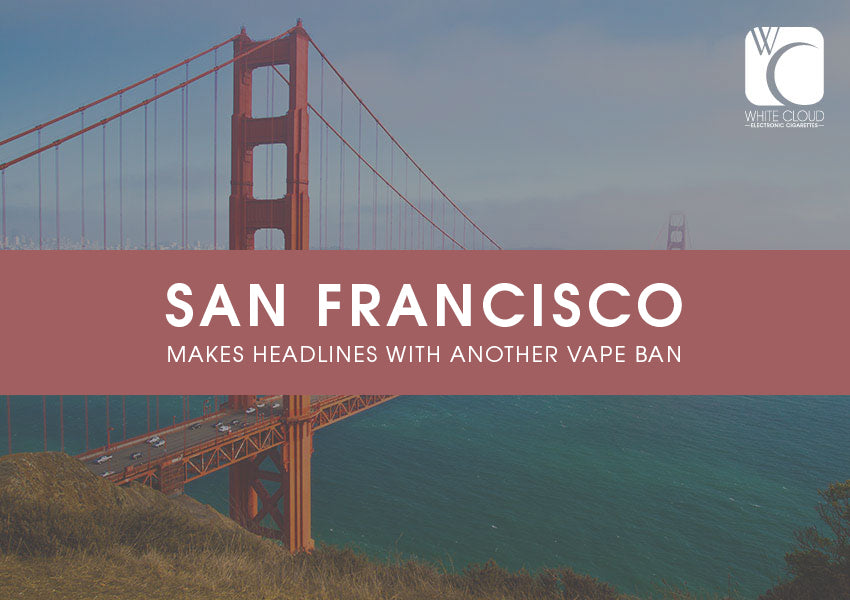San Francisco made headlines last year with the implementation of a ban on flavored tobacco and vapor products, and now they’re back in the spotlight with an even bigger ban. That’s right – San Francisco has effectively banned the sale and distribution of electronic cigarettes and vapor products within city limits.
All About San Francisco’s Vape Sale Ban

San Francisco’s new vape ban piggybacks on initiatives to combat youth vaping. In addition to banning the sale and distribution of vapor products within city limits, the new ban will also prohibit online sales and delivery to San Francisco’s residents, forcing both vapor companies and of-age vapers to go elsewhere. The ban also does not include combustible cigarettes, which leads to the question of whether or not San Francisco vapers will travel outside of the city to continue purchasing vapor products, or simply go back to smoking, The latter would be like taking a step backwards considering the steady decline and record lows in smoking rates since vapor products entered the market back in 2007, which leads to the next question: Is this really the right move?
Is San Francisco’s Vape Ban Justified?

San Francisco city officials have been playing dirty with their initiatives to ban vaping products and threaten the location of Pier 70, which is home to a major vapor company controlling three quarters of the market. In a joint effort with Chicago and New York in March of this year, City Attorney Dennis Herrera sent a letter to the FDA to raise complaints about vaping products being allowed to stay on shelves without an FDA-approved premarket tobacco application (PMTA) and demand the process be expedited.
The PMTA process is included in the provisions of the FDA’s deeming regulations of vapor products, which originally stated that vapor products may remain on shelves for two years after the implantation of the regulations in August of 2016 and for an additional year after submitting a PMTA (while also being able to remain on the market until a decision is made).
In 2017, the PMTA deadline was extended to August 8, 2022 for non-combustible tobacco products when the agency announced a new comprehensive plan for regulating tobacco and nicotine products with a goal to ensure the agency has a solid foundation for effectively and efficiently implementing the Tobacco Control Act of 2009.
This year, the deadline was changed yet again when at least a handful of health organizations filed a lawsuit against the FDA to force an earlier PMTA deadline. On May 15, a judge ruled in favor of the health organizations, except for the request to move the deadline to just four months after the judge’s ruling and instead setting the deadline to within 10 months of the ruling. This gives vapor companies until May of next year to submit their PMTA applications or be forced to remove their products from the market, although there is yet another lawsuit against the FDA underway.
The Battle Over FDA’s PMTA Deadline Continues

The new lawsuit initiated by the Vapor Technology Association (VTA) is yet another effort from vaping organizations to save the more than 160,000 jobs at the small and medium-sized vapor companies across the country, with a violation of the Administrative Procedure Act at its core. This act requires the agency to provide advance notice with an opportunity for public comment.
In the meantime, the City of San Francisco states that vapor products with PMTA approval will not be included in the ban. But, as the city knew at the time of the ban’s passing, not a single independent vapor company had submitted a premarket tobacco application (PMTA) because of the uncertainty of the FDA’s deeming regulations and changing deadlines, not to mention the exponential costs associated with the application of which, in the end, may not even be approved. It wasn’t until the court’s ruling in favor of changing the PMTA deadline to May of next year that an independent vapor company bit the bullet and expedited its original application to become one of the first to submit a PMTA ahead of the May 2020 deadline.
So, is San Francisco’s vape ban a dirty move? People who support the ban would say it’s not; however, those who oppose the ban would say it’s not only dirty but unjustified. Additionally, the city is demanding that the FDA provide them with documents and expedite its premarket review policies on vaping products within their city; therefore, giving power to the City of San Francisco to make its own determination about the safety of vaping and e-cigarette products.
How Will the Ban Impact San Francisco Residents?

According to the legislation, the ordinance will become effective 30 days after the enactment and will become operative six months after the effective date. The ordinance was signed by Mayor London Breed on Friday, June 29, putting the effective date around July 28 and the operational date in January 2020.
Not only will the ban prohibit sales within city limits, but also applies to online sales as it prohibits the shipment of vapor products to San Francisco residents and businesses. This provision of the ban would be almost impossible to regulate and enforce; however, most legitimate vendors would simply refuse to ship their products to San Francisco residents to avoid any fines and legal problems. Residents will instead be forced to travel outside of San Francisco to purchase their vaping products.
Additionally, if the City of San Francisco has its way, vaping in public places will also be prohibited, which means residents will only be able to vape at their residence. Meanwhile, people across the street from City Hall can be seen smoking traditional cigarettes…
Opponents of the band say San Francisco’s vape ban “isn’t just bad policy, it’s bad for public health by focusing on what years of research has shown to be the lesser of two evils. The minimum smoking age in California has raised from 18 to 21 in 2016, while teen smoking has been steadily declining since 2011. but those statistics seem to go unnoticed when it comes to policies surrounding vaping.
San Francisco city officials are so focused on curbing teen vaping, they’re forgetting about the original fight – to protect the public health of all ages in their city. By cutting off access to what has been recognized as a generally safer alternative, even by the American Lung Association, the city is putting their residents at risk of going back to smoking, while also putting the people who own, operate, and/or work at the nearly 800 business selling vapor products out of a job. As a result, the San Francisco’s own economy might go up in smoke.






